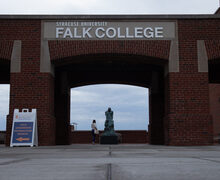Letter to the Editor : Provost, CFO’s figures defending SU’s educational strength don’t hold up
Recently, Provost Eric Spina and Lou Marcoccia, executive vice president and chief financial officer, offered a set of basic facts for judging the performance of Syracuse University. We applaud their shift to a fact-based discussion.
But their op-ed in The Post-Standard sometimes clouded as much as it clarified.
They state that ‘since 2009, the university has hired 250 full-time faculty members.’ This leaves the impression that SU has 250 more faculty members today than then. Other public data offer a clearer picture. Our sources are SU’s own Web page, the university’s Office of Institutional Research and the local chapter of the American Association of University Professors. All three provide readily accessible public data. We take 2005 as the base year for our calculations because the current administration would have no influence on hiring practices before that time. AAUP says there were 873 full-time faculty members at the university in 2005, the SU Web page shows 958 and OIRA publishes 879. In 2011, the same three public sources present these totals for full-time faculty — 976, 1062 and 981, respectively. Taking the average gain across the three sources, SU’s full-time faculty has increased by 103 during Chancellor Nancy Cantor’s years. If you use the same sources and calculate the increase from 2009-11, the time frame in the op-ed, the number is less than 40.
Spina and Marcoccia state that expenditures per student ‘have kept pace with growth’ and cite a range of data, not all of which is open to inspection. Drawing again on publicly available data from university reports, our calculations suggest a slightly different conclusion. We are primarily focused on what happens to the tuition dollars moms and dads pay to SU each year. We simply take the amount in billed tuition; subtract the cut the administration takes out of that income for its own use along with the financial aid that is immediately paid out to discount tuition in the marketplace; and then we use the remaining figure as the amount left to be directed to the academic mission of the schools and colleges. The resulting amount has indeed gone up, from $168.5 million in 2006-07 to $195.8 million in 2010-11. So has student enrollment during that time frame, from 12,144 undergraduates to 13,878. Using those numbers and adjusting for inflation over that time period, the average spent per student drops from $15,520 to $14,109, which represents roughly a 9 percent decline.
We all agree the university endowment has not markedly increased in the last decade. Spina and Marcoccia cite the recession and stock market ups and downs for the lackluster performance. They also note that many other academic institutions show similar poor results. Yet, when we look back over the last decade at our retirement accounts (our personal endowments so to speak), they have performed far better, roughly doubling, and we had no billion-dollar fundraising campaign to enrich our portfolios. Granted, we were conservative and highly diversified. Unlike the university, we sold nothing into a declining market, as IRS declarations document SU must have done, taking a $120 million real loss in 2008. We puzzle over how we two could have weathered recent financial storms seemingly so much better than the best and brightest in America’s academic institutions.
Bob McClure
Chapple Family Professor Citizenship and Democracy Emeritus
Jeff Stonecash
Maxwell Professor of Political Science
Published on November 9, 2011 at 12:00 pm




